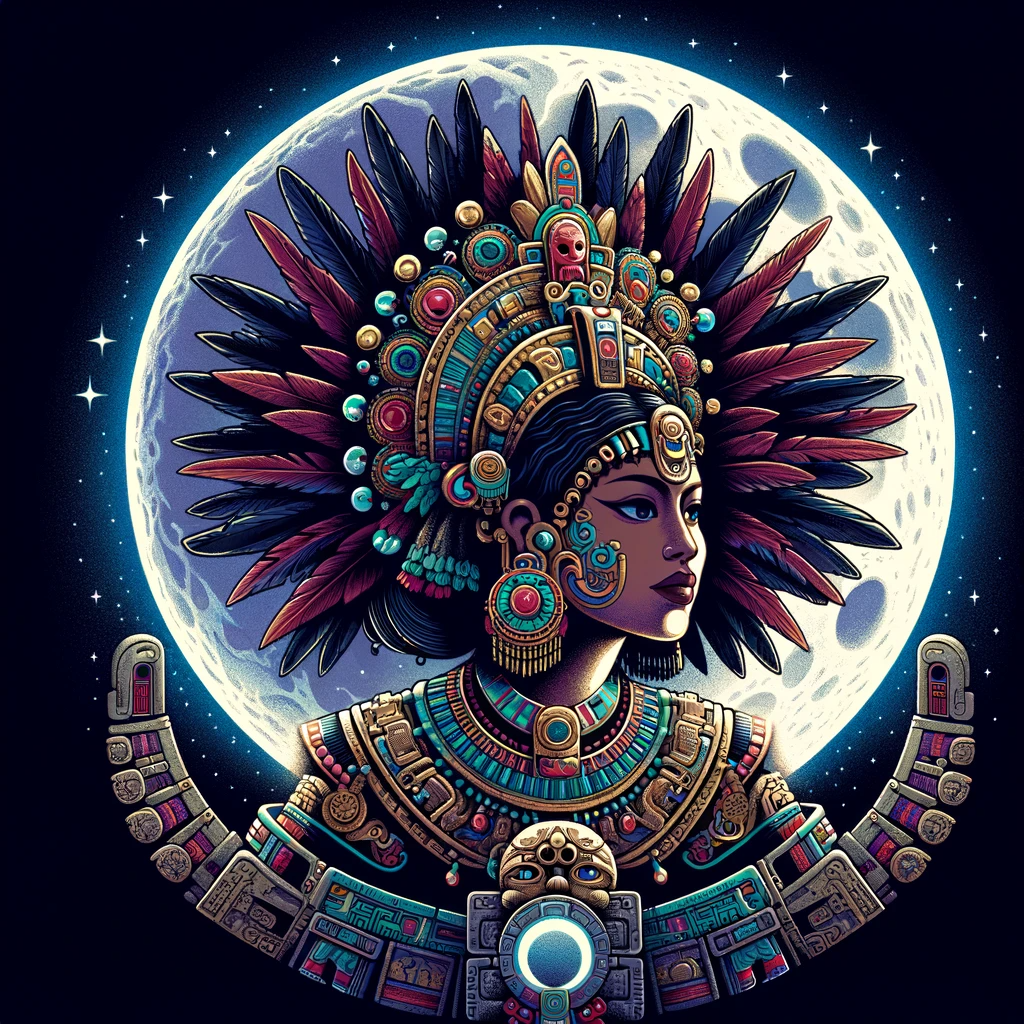
In the pantheon of Aztec mythology, Metztli holds a unique and enigmatic position as the deity of the moon. This celestial figure embodies the mysteries and complexities of the lunar cycle, influencing various aspects of Aztec culture, religion, and daily life. The reverence and fear associated with Metztli reflect the Aztecs' deep connection with the natural world and their understanding of the celestial forces.
Origins and Name
Metztli, also known as Meztli or Metzi, is derived from the Nahuatl word for moon, "mētztli." This deity's origins are intertwined with the creation myths and cosmology of the Aztecs. Metztli is often depicted as a counterpart to the sun god, Tonatiuh, representing the balance between day and night, light and darkness. This duality is central to Aztec mythology and is reflected in many aspects of their religious practices.
Depictions and Symbolism
The iconography of Metztli is varied and symbolic. Often portrayed as a young woman or an old man, Metztli embodies the phases of the moon. The waxing and waning of the moon were believed to be indicative of Metztli's changing moods and powers. The deity is frequently depicted with symbols such as rabbits, which were associated with the moon due to the Aztecs' interpretation of the lunar maria as resembling a rabbit.
Cultural Significance
In Aztec society, the moon played a crucial role in the regulation of time and the calendar. Metztli's phases were used to determine agricultural seasons, religious festivals, and other important events. The deity was also associated with water, fertility, and growth, linking the lunar cycle to the rhythms of nature and human life.
Religious Practices and Worship
The worship of Metztli involved various rituals and ceremonies, often coinciding with specific lunar phases. Priests and devotees would offer prayers, perform dances, and make sacrifices to appease the deity and ensure balance and harmony in the world. The rituals dedicated to Metztli were also believed to influence the tides, rainfall, and crop growth.
Metztli in Mythology
In Aztec mythology, Metztli is featured in several tales that explain natural phenomena and the workings of the universe. One prominent story involves Metztli's role in the creation of the fifth sun, where the deity sacrifices itself to provide light during the night. These myths underline the Aztecs' view of sacrifice and renewal as essential elements of the natural order.
Conclusion
Metztli, the Aztec deity of the moon, is a fascinating figure that encapsulates the depth and complexity of Aztec mythology. As a symbol of balance, renewal, and the cyclical nature of life, Metztli's influence extended beyond the religious sphere, shaping the Aztecs' understanding of the world around them. Today, Metztli remains a testament to the rich cultural and spiritual heritage of the Aztec civilization, continuing to intrigue and inspire people around the globe.
Origins and Name
Metztli, also known as Meztli or Metzi, is derived from the Nahuatl word for moon, "mētztli." This deity's origins are intertwined with the creation myths and cosmology of the Aztecs. Metztli is often depicted as a counterpart to the sun god, Tonatiuh, representing the balance between day and night, light and darkness. This duality is central to Aztec mythology and is reflected in many aspects of their religious practices.
Depictions and Symbolism
The iconography of Metztli is varied and symbolic. Often portrayed as a young woman or an old man, Metztli embodies the phases of the moon. The waxing and waning of the moon were believed to be indicative of Metztli's changing moods and powers. The deity is frequently depicted with symbols such as rabbits, which were associated with the moon due to the Aztecs' interpretation of the lunar maria as resembling a rabbit.
Cultural Significance
In Aztec society, the moon played a crucial role in the regulation of time and the calendar. Metztli's phases were used to determine agricultural seasons, religious festivals, and other important events. The deity was also associated with water, fertility, and growth, linking the lunar cycle to the rhythms of nature and human life.
Religious Practices and Worship
The worship of Metztli involved various rituals and ceremonies, often coinciding with specific lunar phases. Priests and devotees would offer prayers, perform dances, and make sacrifices to appease the deity and ensure balance and harmony in the world. The rituals dedicated to Metztli were also believed to influence the tides, rainfall, and crop growth.
Metztli in Mythology
In Aztec mythology, Metztli is featured in several tales that explain natural phenomena and the workings of the universe. One prominent story involves Metztli's role in the creation of the fifth sun, where the deity sacrifices itself to provide light during the night. These myths underline the Aztecs' view of sacrifice and renewal as essential elements of the natural order.
Conclusion
Metztli, the Aztec deity of the moon, is a fascinating figure that encapsulates the depth and complexity of Aztec mythology. As a symbol of balance, renewal, and the cyclical nature of life, Metztli's influence extended beyond the religious sphere, shaping the Aztecs' understanding of the world around them. Today, Metztli remains a testament to the rich cultural and spiritual heritage of the Aztec civilization, continuing to intrigue and inspire people around the globe.